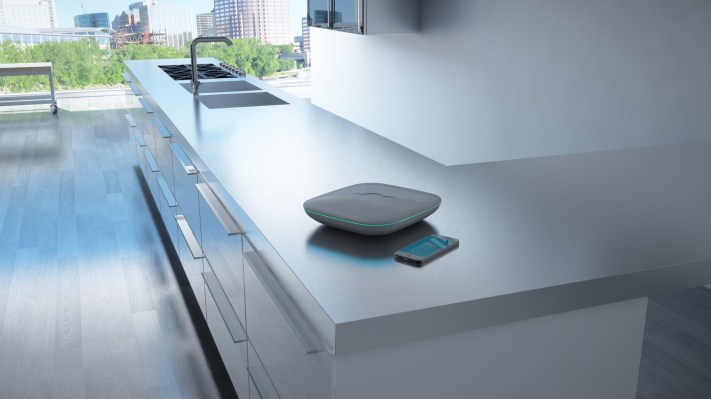We’ve seen smart home security systems before, such as Canary, which took in a $10 million Series A round from Khosla Ventures back in March. We’ve also seen wireless in-home hubs focused on controlling your lighting or heating. And smart sensors for monitoring indoor air quality. Neoji is a smart home hub that’s ambitiously aiming to bundle all those function into one AI-powered hub device for your home, controlled from the comfort of your armchair or elsewhere via the requisite Android and iOS app.
The French team behind the device is currently running a crowdfunding campaign on Indiegogo to take their prototype into commercial production. Fittingly enough, for such an ambitious monitoring device, they have an meaty funding goal of $100,000, although their campaign is a flexible funding one — which means they will receive all pledged funds when it ends in 58 days time, even if they don’t hit that goal.
What exactly does Neoji promise to be able to monitor? The device has built-in movement sensors, a microphone, voice recognition tech and machine learning algorithms so it can alert the user to unusual activity in the home — whether that’s your baby crying, or an elderly relative falling over, or an unfamiliar voice that could signify an intruder.
Neoji says its algorithms learn and adapt to the normal rhythms and sounds of your home so they aren’t triggered by standard stuff like the dog being, well, the dog. But that’s a pretty ambitious claim, so it remains to be seen how smart and adaptive their algorithms really are.
“The more you work with Neoji, the smarter it becomes, and the more customized it will be to your home,” is what they say. So you’re clearing going to have to baby Neoji through a learning curve of false alarms. And probably be willing to trade some false alarms for a greater sense of security that you are at least being alerted to goings on at home when you’re out and about.
As well as security-focused stuff, Neoji also includes sensors so it can measure and track indoor air quality and temperature — so it could send an alert about an unusual temperature spike, for instance. And sense for the presence of mold by tracking humidity levels.
It is also being designed as an open hub device so it can hook into other smart in-home devices, such as smart thermostats, smart meters and wireless lightbulbs, so you can control other smart gizmos and do things like remotely control your home lighting so it looks like you’re at home, and track your energy consumption via Neoji. Current supported wireless standards include Apple’s iBeacon, Zigbee, 6LoWPAN, Enocean, KNX and M-Bus.
A premium version of the device also includes a camera with a fixed 180 degree view so you can remotely log in to do a visual check after being alerted that something unusual is happening at home with that version of Neoji. So it’s offering Dropcam-style functionality at that point.
In terms of range, one Neoji device is apparently able to monitor “one to two rooms” (presumably the sound sensing might span more than one room, but the camera obviously won’t be able to see through walls). So, if you want your whole multi-room mansion to be entirely covered it’s going to get expensive. The consumer Neoji device starts at $299 for the entry-level model (without a camera) rising to $399 for all the bells and whistles. There is also a $499 developer version with an SDK.
Neoji was founded in May 2013 by serial entrepreneur François Bordes who founded energy consumption tracking platform, MyCO2; hardware engineer Cyrille Dayanga who has done prior work on smart home technologies; and software engineer Sébastien de Salvador, who has previously worked on cloud platforms and energy monitoring systems.
The founders have been funding the project themselves thus far. Despite their range of relevant skills, it’s still going to be a challenge for Neoji to pull off such a feature-packed and complex device — and ensure it’s both effective and usable. If all goes to plan, the team is aiming to ship to backers starting from March next year.
